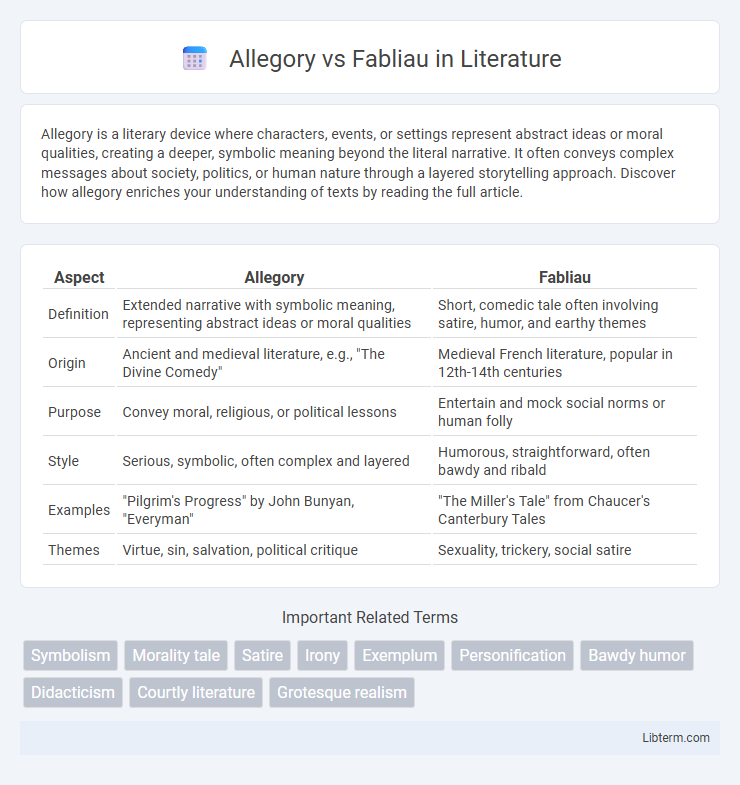Allegory is a literary device where characters, events, or settings represent abstract ideas or moral qualities, creating a deeper, symbolic meaning beyond the literal narrative. It often conveys complex messages about society, politics, or human nature through a layered storytelling approach. Discover how allegory enriches your understanding of texts by reading the full article.
Table of Comparison
| Aspect | Allegory | Fabliau |
|---|---|---|
| Definition | Extended narrative with symbolic meaning, representing abstract ideas or moral qualities | Short, comedic tale often involving satire, humor, and earthy themes |
| Origin | Ancient and medieval literature, e.g., "The Divine Comedy" | Medieval French literature, popular in 12th-14th centuries |
| Purpose | Convey moral, religious, or political lessons | Entertain and mock social norms or human folly |
| Style | Serious, symbolic, often complex and layered | Humorous, straightforward, often bawdy and ribald |
| Examples | "Pilgrim's Progress" by John Bunyan, "Everyman" | "The Miller's Tale" from Chaucer's Canterbury Tales |
| Themes | Virtue, sin, salvation, political critique | Sexuality, trickery, social satire |
Understanding Allegory: Definition and Characteristics
Allegory is a narrative device where characters, events, and settings symbolically represent abstract ideas or moral qualities, creating deeper meaning beyond the literal story. It often features a clear, structured correspondence between the narrative elements and their symbolic interpretations, aiming to convey ethical, political, or spiritual messages. Unlike fabliaux, which use humor, satire, and everyday scenarios for entertainment, allegories prioritize didactic purposes and thematic depth.
What is a Fabliau? Origins and Key Features
A fabliau is a short, comic, and often bawdy narrative poem originating in 12th and 13th century medieval France, characterized by its straightforward language and satirical tone. Typically centered around everyday characters like peasants or tradespeople, fabliaux use humor and clever plots to expose human vices and social absurdities. Unlike allegories, which convey deeper moral or philosophical meanings through symbolic storytelling, fabliaux emphasize entertainment and critique through exaggerated, realistic scenarios.
Historical Context: Allegory and Fabliau in Literature
Allegory emerged prominently in medieval literature as a vehicle for conveying complex religious and moral lessons, with works like Dante's "Divine Comedy" exemplifying its didactic purpose. Fabliaux, by contrast, flourished in 12th- and 13th-century France as short, comedic tales that critiqued social norms through earthy humor and satire. The historical context of these genres reflects their divergent roles: Allegory served as a tool for spiritual edification during the Middle Ages, while Fabliau offered popular entertainment that subverted established authority and ridiculed societal conventions.
Purpose and Function: Allegory vs Fabliau
Allegory serves a didactic purpose, using symbolic figures and narratives to convey moral, religious, or political lessons, often aiming to provoke reflection and ethical understanding. Fabliaux, by contrast, function primarily as comedic tales that expose human follies and social vices through satire, humor, and often bawdy content, entertaining audiences while critiquing societal norms. The purpose of allegory centers on instruction and enlightenment, whereas fabliau emphasizes amusement and social commentary.
Style and Structure Comparison
Allegories employ a symbolic and extended narrative style, often utilizing personification and moral lessons to convey complex ideas, while fabliaux favor a straightforward, concise, and humorous storytelling method rooted in everyday life and satire. Structurally, allegories are typically longer with layered meanings and a clear, unified theme, whereas fabliaux consist of short, episodic tales designed for quick entertainment with punchy endings. The formal tone of allegories contrasts sharply with the bawdy, colloquial language characteristic of fabliaux's style and structure.
Popular Allegories in Classic Literature
Popular allegories in classic literature often use symbolic characters and narratives to convey deeper moral, spiritual, or political meanings, as seen in works like John Bunyan's *The Pilgrim's Progress* and George Orwell's *Animal Farm*. Unlike fabliaux, which are short, comic, and often bawdy tales focusing on everyday life and human folly, allegories employ extensive symbolism throughout the entire narrative to teach or critique societal issues. The enduring appeal of allegories lies in their layered storytelling, allowing for multifaceted interpretation beyond the surface plot.
Notable Examples of Fabliau Stories
Notable examples of fabliau stories include "The Miller's Tale" and "The Reeve's Tale" from Geoffrey Chaucer's *The Canterbury Tales*, which showcase crude humor and satirical takes on social classes. Fabliaux commonly feature clever plot twists, bawdy content, and focus on everyday characters, contrasting with the moral or symbolic nature of allegories like John Bunyan's *The Pilgrim's Progress*. These stories emphasize earthly, often vulgar humor over the spiritual or philosophical messages found in allegorical narratives.
Themes Explored in Allegory and Fabliau
Allegories explore themes of morality, spirituality, and human virtues through symbolic characters and narratives, often addressing complex philosophical or ethical questions. Fabliaux focus on earthly and often ribald themes such as cunning, trickery, and social satire, emphasizing humor and the foibles of everyday life. The thematic contrast highlights allegory's aim for moral instruction versus fabliau's intent to entertain and critique social norms.
Audience and Cultural Impact
Allegories engage audiences through symbolic narratives that convey moral, spiritual, or political messages, appealing to readers seeking depth and reflection, often influencing cultural and intellectual traditions over centuries. Fabliaux, meanwhile, target a broader, more popular audience with bawdy humor and satirical episodes, reflecting common social behaviors and class dynamics, thereby shaping medieval cultural identity by preserving and critiquing everyday life. The contrasting impact of allegories and fabliaux highlights the diverse ways medieval literature influenced both elite and popular culture through targeted storytelling techniques.
Allegory vs Fabliau: Key Differences Summarized
Allegory uses extended symbolism to convey deeper moral or political meanings, often through characters and narratives representing abstract concepts. Fabliau is a short, comedic tale rooted in bawdy humor and everyday life, typically highlighting human folly without layered symbolic meanings. While allegories emphasize moral lessons, fabliaux prioritize entertainment and satire.
Allegory Infographic

 libterm.com
libterm.com